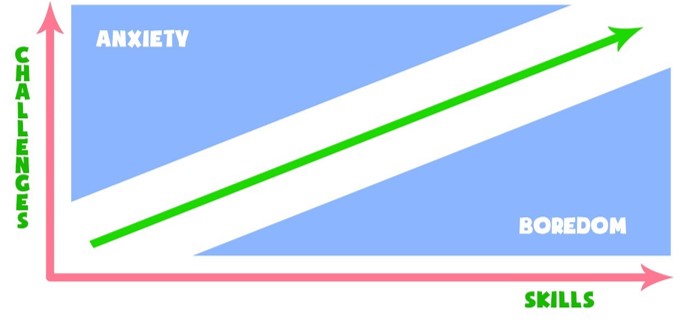Tools
Flow Theory
Find the right balance between the level of skill and the size of the challenge at hand.
WHAT IS IT?
Flow is a mental state and a feeling of energized focus, full immersion and success in the process of an activity. It was theorized by Mihalyi Csikszentmihalyi, a Hungarian-American psychologist.
Flow comes from the balance between the level of skill and the size of the challenge at hand. When designing the challenges for your game, it is important to consider the skill level of your player in order to get them in the right flow. If the challenge of the activity is too high, they will become frustrated. As they continue, their ability rises, however, and if the challenge level stays the same, they will become bored.
WHY USE THIS?
You want to have the excitement just right, and depending on your game, this either means leaning more toward anxiety, more towards relaxation, or a balance between them. Often much can be achieved thematically through an imbalance between challenge level and skill level. Horror games often keep challenges significantly above the player’s level of competency in order to create a feeling of anxiety. On the other hand, so called “relaxation games” keep the level of challenges significantly below the player’s competency level, in order to achieve an opposite effect. It is advised to describe flow in your Game Design documentation, so you can use it as a discussion tool in collaborative design meetings. It serves as a reminder for the team and provides a quick evaluation tool during the development process.
HOW DO I USE THIS?
Flow Design Checklist
Use the checklist when designing specific elements of the game such as levels, quests, challenges, or interactions. Answer the questions to see of your game has taken Flow Theory into account.
- Clear goals
Are the goals of this game element clearly defined and understandable by the player? Do they know what they need to achieve? You could use Goal Loops to make these clear. - Concentration on the task at hand
Does this game element minimize distractions and encourage focused concentration from the player? Are they not thinking about other things right now and fully focused on the challenges presented in the game? You could ask a player during Playtesting if they were thinking about other things than the game while playing. - Loss sense of time
How does the pacing and flow of this game element align with the player’s perception of time? Is it engaging and enjoyable? Is the player hooked by the activities that he’s doing and doesn’t he realize that the time flies while doing it? You could time the playtest and ask the player how long they think the play-session lasted. - Rewards
Does this game element tap into players’ intrinsic motivation, providing enjoyment for its own sake? Is the experience inherently rewarding, providing satisfaction independent of external rewards? You could use Reward Systems to have rewards implemented by design. - Direct and immediate feedback
Does the game provide immediate and clear feedback to players regarding their actions and progress? Use audiovisual cues to make sure you communicate wrong and right actions of the player to the player. - The balance between player skills and challenge
Is there a balance between the challenge presented by this element and the skill level of the target audience? Is there a dynamic adjustment of the challenge based on the player’s skill level, creating a continuous loop of challenge and improvement? You could use Feedback Loops to balance your game. - Loss of consciousness
Is the design immersive enough to help players lose awareness of themselves while engaging with this element? A hard one to actually determine, but you could find out during a playtest. - The player controls the situation and the activity
Does this game element provide a sense of control and agency to the player over their actions and decisions? Does the objective seem reachable to him? Besides measuring this during tests, you could also ask about it during a questionnaire.
REFERENCES
Tracy Fullerton – Game Design Workshop: A Playcentric Approach To Creating Innovative Games
Mike Oppland – https://positivepsychology.com/mihaly-csikszentmihalyi-father-of-flow/#Mihaly-Csikszentmihalyi
Daniel Berube – https://thinkgamedesign.com/flow-theory-game-design/
ChatGPT
NEXT STEPS
Feedback Loops, Goal Loops

